Japanese "kamikaze" pilots died for their homeland and the emperor, crashing into the decks of American ships with their planes. The generals who sent them to their deaths considered them effective, so the arsenal of suicide weapons was expanded to stop the Americans. In the last months of the war, Japanese suicide soldiers attacked the enemy not only from the air, but also from water, from under the water, from the ground, and even ... from under the ground.
Japan was the only country involved in World War II to send organized suicide troops into the fight. At the end of the war, the Germans also considered such a step and even formed a suicide squadron (Rammkommando Elbe), but Hitler's consent, time and fuel were not available for its use on a larger scale.
The Japanese have gone much further. Their suicide pilots took part in the fight and carried out their missions until the last days of the war. Interestingly, Japanese suicide weapons were not only airplanes, but also explosive motorboats, one-man torpedoes, tanks, and even belts around the soldiers' bodies explosives, known today as "shahid belts".
In preparation for the invasion of the Americans on the home islands of Japan, squads of suicide divers were being formed, waiting for an opportunity to attack under water, in specially built underwater shelters! They were to create mobile, underwater minefields. Among the Japanese suicide weapons, the "Kamikaze" planes were used first ...
Japan on the defensive!
From 1943, the Allies fared better in the war with Japan in the Pacific. After several naval battles won by the US Navy, a land offensive was launched and the American divisions in bloody battles captured island after island, slowly breaking into the vast area occupied by the Japanese in 1942.
Desperate junior Japanese officers, who wanted to stop the Americans at all costs, proposed the use of several types of suicide weapons as early as 1943. o live torpedoes and suicide planes . However, then there was still a chance to stop the American fleet with conventional weapons, so these ideas met with opposition from the higher command and the emperor himself. Until…
In the Battle of the Philippine Sea on June 19–20, 1944, the Japanese lost three aircraft carriers:Shōkaku, Taihō and Hiyō, and 315 aircraft. The Americans did not lose any ships and lost "only" 123 aircraft. The scales of victory definitely tilted towards the Americans. In Japan, it was decided to take radical steps - the formation of volunteer suicide units began.
The matter was dealt with "professionally", starting with the design of special planes for the "Kamikaze". The experiments showed that the planes hitting the decks of American ships had to have a powerful explosive in order for their attack to be effective and ended in eliminating the ship from combat, and preferably - sinking it. The command wanted the Kamikaze attacks to be effective. If the pilot was about to die, he had to inflict as much damage on the enemy as possible.
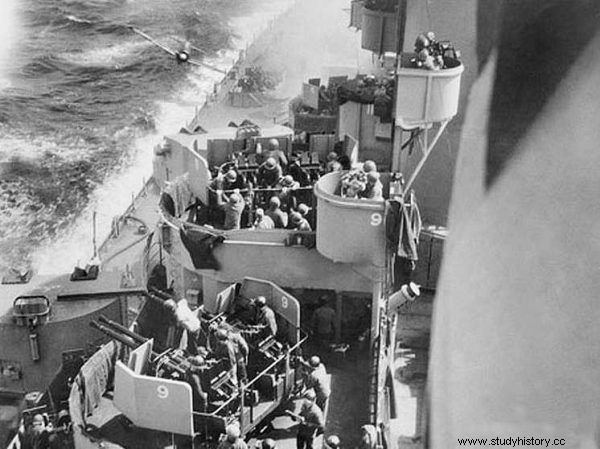
Kamikaze during the attack on the American ship
It should be remembered that the Japanese understanding of war was completely different from the European one. According to the samurai code "Bushido", death in battle was glorious, and the fallen became a hero and a role model for others. In no situation, even extremely hopeless, was units or individual soldiers allowed to enter. Taken prisoner disgraced the soldier and his family. In the event of ammunition exhaustion, the soldiers were to launch attacks on bayonets. The officers were expected to lead these strikes.
The US marines who had fought the Japanese in the Pacific islands since the Battle of Guadalcanal knew the terror of the night attacks very well, and the cry of "banzai" was the worst of the wake-up call. They knew that the "yolks", pinned to the wall, would dig out of the destroyed bunkers, shelters and specially prepared underground tunnels to launch a bloody attack on the marines' positions. In most cases these were suicide strikes, but they were not yet called "Kamikaze" . This formidable term came much later.
Kamikaze - divine wind
The word "kamikaze" means "divine wind" in Japanese. This was the name of the typhoons that destroyed the Mongol invasion fleets heading for Japan twice in 1274 and 1281. The Japanese considered this evidence of divine protection over their country. Generals who decided to send suicide pilots into the air during World War II hoped that their planes would sweep American ships out of the sea, just as the "divine wind" destroyed the Mongol fleets.
The official name of WWII suicide units was "Shinpū Tokubetsu Kōgekitai", meaning "Divine Wind Special Attack Squad". When referring to suicide attacks, the term "Tokko" was also used - special attack, and the pilots of the special units called themselves "Shinpū-tokkōtai". The first "kamikaze" was probably Rear Admiral Masafumi Arima , commander of the 26th Air Fleet in the Philippines, who on October 14, 1944 attempted to crash his plane - the Yokosuka D4Y Suisei bomber into an American carrier. It is worth noting that in this case the high commander himself launched the attack, setting an example for his soldiers, rather than giving orders from the deep rear.
A large-scale attack took place on October 25, 1944, during the Battle of Leyte Bay, when nine Mitsubishi A6M2 Zero fighters attacked American ships. Escort aircraft carrier USS St. Lo was hit by a plane armed with a bomb and sank after 30 minutes. The pilot of this suicide machine and the performer of the first successful "kamikaze" attack was probably 23-year-old Yukio Seki. 113 sailors of the ship's 889 crew died.
For US Navy seamen, the "Kamikaze" were a curse and a much greater threat than the German U-boats hunting in the Atlantic at the beginning of the war. In ports and ships, shocking stories were told of airplanes filled with fuel and bombs crashing into the decks of American carriers, battleships and destroyers. There are several films made during such attacks, and they still make a shocking impression today.
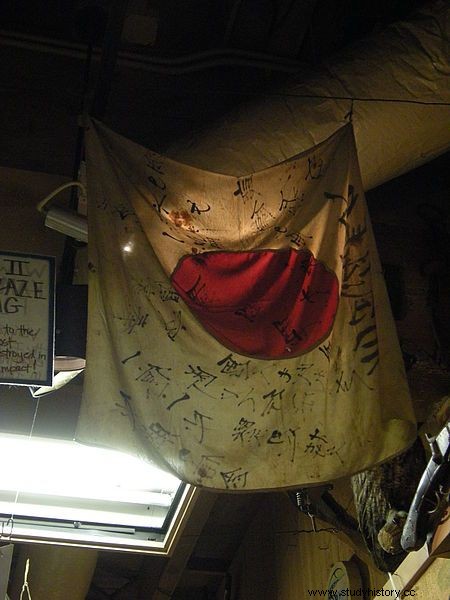
Kamikaze flag
The impact of a suicide plane caused fires and explosions aboard the ship, and each successful attack resulted in hundreds of seriously injured, burned and dozens of deaths. Most of the ships hit by the "Kamikaze" were saved, but they had to be returned to ports for months of repairs.
Stop the Americans!
In 1944, the advances of the US troops in the Pacific were more and more advanced and the defeats of the imperial army more and more spectacular. Americans captured small atolls and larger islands, despite the desperate defense of the Japanese infantry. Technology and logistics won over fanaticism. Even perfectly constructed bunkers and shelters, masked with vegetation, equipped with underground tunnels and plentifully supplied with ammunition, had to succumb to flamethrowers, incendiary bombs or heavy artillery fire.
The battles on land were bloody, and in their course there were constant attacks by Japanese suicide units, which today mass culture incorrectly calls "kamikaze". In addition to the already mentioned bayonet attacks, the Americans tried to stop suicide sappers armed with anti-tank mines mounted on long poles. The mines were to be attached to the hulls of American armored vehicles.
The 'Nikkau' tactic, i.e. human mines, was also used. Soldiers hung with explosives carried on the belt and in a backpack threw themselves between the tracks of tanks and blown them up with them. Actions of this type took place, among others during the fighting in the Philippines in 1944, and also in Iwo-Jima and Okinawa in 1945.
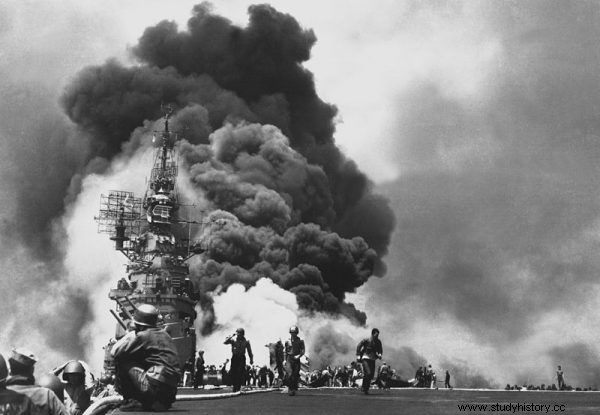
Aftermath of the kamikaze attack - USS Bunker Hill is on fire
Even kamikaze tanks were used against American tanks! This happened on the island of Luzon (Philippines), where General Tomoyuki Yamashita ordered suicide attacks using the Type 97 and Type 95 tanks. A powerful explosive device was mounted on the front armor of the tanks, which was to explode after a collision with an enemy vehicle. The attack on April 17, 1945 proved ineffective. Japanese tanks rammed the American M4 Sherman, but the explosive did not explode.
Bloody Iwo-Jima
As the Americans approached the Archipelago of the Japanese Islands, the defense of the imperial troops tightened. Sometimes it took several days to get the small rashes. The battle for Iwo-Jima, scheduled for a week, lasted over a month (February 19-March 26, 1945), and many defenders survived in shelters until April and May.
In the battles for Iwo-Jima, the Japanese used a network of tunnels inside Mount Suribachi, as well as those dug under defensive positions in the rest of the island. The Japanese hid in tunnels during the day and went outside at night , often in territories occupied by Americans.
Terrifying cries of "banzai" were heard then, and from the darkness emperor's soldiers with bayonets mounted on Arisak's rifles and their commanders with sabers or samurai swords in their hands emerged from the darkness. It was during the fighting on Iwo-Jima that American soldiers reported that the Japanese even fired at them "from under the ground". The Japanese allowed themselves to be buried in small one-man shelters, which could not be noticed and destroyed until the soldier hidden in them started firing.
The Americans finally found a simple solution to night suicide attacks. Guard dogs appeared in the units, most often Dobermans, who warned the sleeping soldiers with growling and barking when something disturbing was happening. The storming desperates were stopped by heavy machine gun fire. However, before the island was captured, the Americans lost several hundred soldiers in night strikes. In the entire battle for Iwo-Jima, 6,821 Americans were killed (for comparison, in the fighting on the Omaha beach during the Normandy landings, the American losses amounted to 3,000 killed and wounded).
Flying "Okha" bombs
The Kamikaze planes, the living mines of the Nikkau and the suicide bayonet attacks were only a harbinger of a broader suicide strategy being prepared in Tokyo. First of all, the MXY7 Okha guided flying bomb with rocket propulsion was included in the airborne "Kamikaze" arsenal.
The idea to build such a weapon was reported as early as in 1942 by the transport pilot Mitsuo Ohta. His design was ignored for a long time and only "unearthed" in the spring of 1944. It was taken into account that the construction of a piloted metal and wooden flying bomb is much cheaper than the construction of a fighter plane or a bomb. the use of which was supposed to be "one-time" anyway.
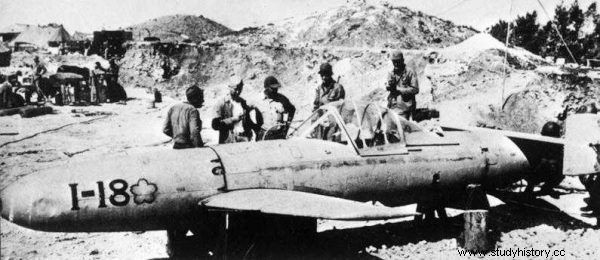
MXY7 Ohka's bomb
The "Okha" bomb was to be transported near American ships by the G4M2e "Betty" bomber flying at high altitude. There, the bomb was detached from the fuselage and it was heading towards the target in a shaft flight. In the last phase of the flight, in order to avoid being shot down, the suicide pilot driving the bomb launched jet boosters suspended under the wings, which gave the machine a speed of 870-965 km / h. in a diving flight. Such a rushing bomb was supposed to hit the deck or the side of an enemy ship. You can imagine the effects of the explosion knowing that the warhead of the "Okha" bomb weighed as much as 1,200 kg.
Fortunately for the Americans, most of the "Okha" bombs were destroyed on land - while still in production or at sea - while being transported to suicide units or even before a combat flight - at airports. The "Yankees", having learned from the "kamikaze" experience, learned to conduct careful radar reconnaissance and to keep short and long-range air patrols in the air. Absolute air control allowed the Americans to shoot down Kamikaze planes far from their target. Most of the 'Okha' bomb-carrying bombers were also intercepted before they were in position to drop suicide bombs.
Kamikaze on and under water
When the American sailors' attention was focused on the sky, danger could also come from the water and from under the water. The miniature and conventional Japanese submarines were still dangerous and could deliver surprising and severe blows (such as the sinking of the USS Indianapolis cruiser by I-58).
Some large submarines carried suicide torpedoes called "Kaiten" (Japanese:turning to the heavens) on their decks. These were rebuilt torpedoes with a compartment for the helmsman, navigation equipment and a periscope. They entered service in the fall of 1944. One submarine carried up to six "Kaitens", and their release could take place under water.
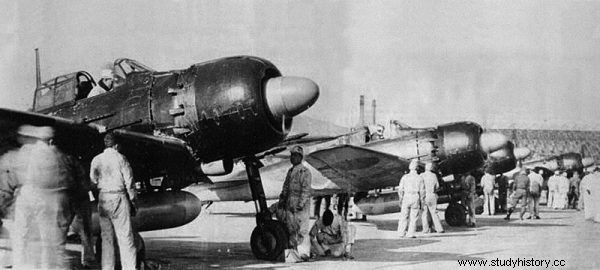
Preparing for a suicide attack by Mitsubishi A6M Reisen
planesBefore the suicide torpedoes were unhooked, their pilots moved from the submarine to their cabins and went hunting. The manned torpedoes had a length of 15 meters, a speed of 42 knots, a range of 12 nautical miles and a warhead weighing 1500 kg. The torpedo leader was theoretically able to leave the cabin before hitting the target, but it was unlikely.
The "Kaitens" were first used on November 20, 1944, but were not successful. They were used in combat until the end of the war with little effect. "Kaitens" easily crashed, due to the low draft they could be spotted and destroyed by planes. In bad weather and large waves, reaching the target was very difficult, and there was no chance of returning to the mothership either. That is why most of the "Kaiten" pilots died without a trace at sea. The torpedo people destroyed only two ships:the tanker USS Mississinewa, sunk on November 20, 1944, and the destroyer USS Underhill, sunk on July 24, 1945. Several other American units were damaged by the "Kaitens", but as many as eight large submarines carrying them were lost.
Suicide motorboats
Another idea of the Japanese staff officers was the use of "Shinyo" type explosive boats (Japanese:seaquake). They also belonged to suicide weapons, because the sailor who was driving them had little chance of survival. His task was to crash into the side of an American ship, as large and most valuable as possible.
In the prow of the "Shinyo" motorboats, 300 kg of explosives were placed, which was enough to tear a large hole in the side of an aircraft carrier or landing craft. In order to increase the chances of the motorboat crew to reach the target, some versions of the motorboats were armed with 120mm "water-water" rockets with a high-explosive incendiary warhead. The primary purpose of rockets, it seems, is to create a lot of noise and smoke, and to give the impression that they are the main weapon of the unit.
The advantage of the suicide motorboats was their small size, weight and simplicity of production. They could be built in small industrial plants, factories and private shipyards. The hull was wooden, and Toyota car engines were used for the drive. The scale of production is evidenced by the construction of 6,200 copies of the "Shinyo" by the end of the war. About 400 motorboats were transported to Okinawa and used in combat.
They sank and damaged 11 American ships, most of them barges and auxiliary units. The rest of the Shinyo boats were left in the Japanese Islands to wait for the American landing. It was planned that they would launch a surprise attack on the ships of the invasion fleet anchored offshore and stop "American barbarians" before they set foot on "Japanese sacred land." Suicide boats were to attack primarily at night and in poor visibility conditions.
If the Shinyo had not stopped the ships approaching the shore, another sea line of defense had been considered. It was supposed to be created by Fukuryu (Japanese crouching dragon), i.e. suicide divers. Underwater training began for six thousand people, who were equipped with a suit, diving pants and boots, and a helmet. By August 1945, a thousand oxygen apparatuses had also been manufactured, and by September 8,000 of them were to be ready! Fukuryu's units were to reach combat readiness in October.
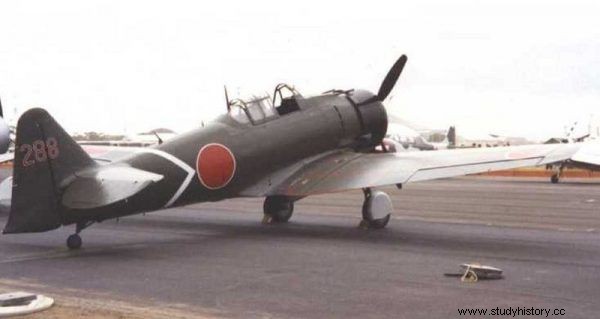
Mitsubishi A6M5 Reisen - Japanese fighter often associated with kamikaze
Divers defending the coast were armed with an assault mine with 10 kg of explosive material placed at the end of a long pole. The first line of defense of the "Fukuruyu" were conventional sea mines, three rows of divers were to wait closer to the shore, 60 meters apart, and individual soldiers were to be spaced every 50 meters.
The alternating positioning of the divers prevented the ships from approaching the shore without "sticking" on an underwater pole with an explosive at the end. There have even been experiments with the creation of underwater shelters, e.g. with the use of concrete pipes in which the "crouching dragons" could hide, waiting for the right moment to attack, or waiting out the outbursts of pole mines. The first branch of "Fukuryu" was established in the summer of 1945 in Yokosuka. These troops were to defend Tokyo Bay and the beaches of Honshu. For the time of the main American landing on the islands, 40,000 suicide divers were planned.
Kamikaze and the atomic bomb
As it turned out, the air attacks by Japanese suicide pilots were not very effective. Almost 4,000 Japanese pilots died in the attacks by the "Kamikaze" planes, who sank "only" 56 and damaged 368 American vessels. The remaining "suicide weapons" sank about 30 more ships. The combat effectiveness was therefore small, but the propaganda effect, especially the impression made on the enemy - enormous, even devastating. Unfortunately, the "Kamikaze" operations were indirectly the cause of the dropping of atomic bombs on Japanese cities - Hiroshima and Nagasaki.
The American command planned in the fall of 1945 to start Operation Downfall - a landing on the home island of Japan. Tough, sustained resistance was expected. It was assumed that the fierce fighting on the great Japanese islands:Honshu, Kyushu, Hokkaido and Shikoku would continue until 1947. The intelligence warned that other types of special weapons were being prepared in Japan, including suicides and hundreds of thousands of samurai descendants ready to die. In this second part of the analysis, the intelligence was wrong:4.6 million soldiers of regular units (66 divisions) were to take part in the defense of Japan, as well as 28 million (sic!) Civilians incorporated into the Voluntary Fighting Corps (similar to the German Volkssturm - editor's note) .).
It was assumed that women and children aged 12 and over would also take part in the defense of Japan. Since the volunteer units had only 2.5 million rifles at their disposal, the American invaders were to be attacked by peasants armed with gasoline bottles, mines on poles, as well as swords, daggers, spears, halberds, pikes, bamboo sticks, forks, shovels and even flails. for threshing grain!
Japan still had around 10,000 aircraft at its disposal, many of which could be quickly adapted to the Kamikaze mission. The already known suicide units were also prepared:miniature submarines, live torpedoes "Kaiten", explosive motorboats "Shinyo" and "Fukuryu" divers.
American staff officers expected huge losses during the landing and subsequent fighting on the home islands. The main part of the invasion operation - the landing on Honshu near Tokyo on March 1, 1946 - was to take part over a million American soldiers and 190,000. vehicles. The most "pessimistic" American forecasts predicted that in the fights for the occupation of the entire archipelago of the Japanese Islands, the American army would lose 1.7 to 4 million soldiers (including 400,000 to 800,000 killed). Between 5 and 10 million defenders were also to be killed.
About 400,000 Americans died during World War II. The United States could not afford to lose another 400,000, so President Harry Truman decided to use a weapon that was to scare the Japanese and convince the further fight to be pointless and it can mean the destruction of an entire nation. That weapon was an atomic bomb. Indeed, it had the expected effect - Japan capitulated. But that's a completely different story.
The last kamikaze pilot was Admiral Matome Ugaki, one of the creators of the Japanese suicide units. On August 15, 1945, he unbuttoned the decorations from his uniform and boarded the plane that took off towards the American fleet. His mission was in vain, the Americans did not record losses that day as a result of the "Kamikaze" attacks ...
